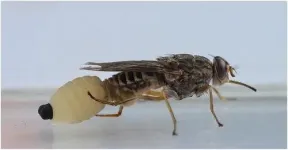(Press-News.org) PULLMAN, Wash. - When it comes to craft beer, the flavor doesn't have to be all in the hops. As a panel of amateur beer tasters at Washington State University recently demonstrated, malted barley, the number one ingredient in beer besides water, can have a range of desirable flavors too.
Researchers recruited a panel of about 100 craft beer drinkers to taste some so-called SMaSH beers--those brewed with a single barley malt and single hop. All the beers contained the same hop variety, called Tahoma, but each had a malt from a different barley genotype, or genetic makeup. Trained tasters can distinguish these easily, but even the untrained panel could taste the difference among five different barley varieties--and definitely favored some more than others.
"We found that the untrained panelists could differentiate among the barley breeding lines in the beer," said Evan Craine, a WSU doctoral student and first author on the study in the Journal of Food Science. "They did a good job of selecting attributes that revealed distinctive profiles for each of the beers."
The panel generally preferred the four barley breeding lines developed at WSU over the control, known as Copeland, a high-quality malting barley widely grown in Washington state. The panelists were able to easily identify the flavor profiles of the beers, such as one with a "fruity and sweet aromatic" flavor and another with a "citrus" profile made with a barley called Palmer, a variety recently released by WSU for commercial use.
While the untrained panel could distinguish flavors from brewed beers, they were not as adept at tasting the differences among "hot steep" samples which are made by combining hot water and ground barley malt before filtering. This creates a sweet liquid--similar to that made by brewers before yeast is added to create alcohol.
The researchers had hoped amateur beer tasters could distinguish flavor differences in the hot steep as it would shorten the testing process for new barley varieties. Corresponding author Kevin Murphy was not ready to give up on the method.
"Hot steep malt still shows a lot of promise," said Murphy, a WSU associate professor of crop and soil sciences. "The next step would be testing it with a trained panel to see if they can distinguish barley varieties. Ideally, we would just set it out to consumers because hot steep malting is great outreach. It gets people involved. They love tasting and talking about it."
While U.S. craft beer drinkers are known for their love of hop-heavy India Pale Ales, the results of this study add evidence that barley malts might be another good way to develop new beers.
For this study, Craine and Murphy worked with Scott Fisk, a faculty research assistant at Oregon State University, to create the malts and brewer Aaron Hart of Moscow Brewing Company to develop the beers, using hops only to add a little bitterness to balance the sweetness from the malt. These types of beers are called "malt-forward." They can be light or strong flavored, ranging in types from lagers and pilsners to ambers and stouts. Hart called the beers developed for this study "American Pale Ales."
More variety from malt-forward beers can potentially benefit not only beer lovers but also the environment and brewers' bottom lines, said Craine.
"In terms of sustainability, hops can be pretty resource intensive, and at least around us in Pullman, we can grow barley that's just rain fed," he said. "Hops can also be really expensive. Brewers are already buying the malt, so if we can find ways to increase the flavor contribution from the malt, hopefully, they can rely less on the hops and save money."
While the hops craze is continuing, the malt-forward beers have the potential to spur the next evolution in craft brewing, said Murphy.
"Just as craft beer flavor has evolved in the last 20 years, we can expect it to continue to change over the next 20, and the new frontier will be adding different barley flavors or barley-hop combinations," he said. "I don't know how many people knew about IPAs 20 years ago, and they exploded. Brewers are very innovative, and I am very excited to see where this goes in the future."
INFORMATION:
An international group of researchers representing thousands of coral scientists across the globe is calling for new commitments and actions by the world's policymakers to protect and restore coral reefs.
In a paper presented July 20 at the International Coral Reef Symposium, the scientists said that the coming decade will likely offer the last chance for policymakers at all levels to prevent coral reefs "from heading towards world-wide collapse."
The paper, developed by the International Coral Reef Society, pushes for three strategies to save the reefs: addressing climate change, improving local conditions and actively restoring coral. ...
The female tsetse fly, which gives birth to adult-sized live young, produce weaker offspring as they get older, and when they feed on poor quality blood.
The study, carried out by researchers at the Universities of Bristol, Oxford and the Liverpool School of Tropical Medicine, was designed to measure how tsetse offspring health is influenced by their mothers' age, and how factors such as the mother's nutrition and mating experience might come into play.
In many animals, females show signs of reproductive ageing - where offspring health declines with maternal age - but there is huge variation within species in how rapidly this ageing occurs.
Scientists found that female tsetse that experience ...
For more than 20 years, Makoto Miyata from Osaka City University has been studying the gliding motility of the parasitic bacterium Mycoplasma mobile (M. mobile). It is a mechanism consisting of an external "grabbing" structure and internal "motor" - the motor having yet to be clarified on a molecular level. In collaboration with Osaka University and Kanazawa University, his research team used electron microscopy and high-speed atomic force microscopy (high-speed AFM) to reveal that the bacteria's molecular motor consists of two ATP synthase-like complexes, suggesting an unexpected evolution of the protein. Their findings were published in mBio.
Based on genetic information, researchers have suggested that the ...
Imagine you're a CEO who wants to promote an innovative new product -- a time management app or a fitness program. Should you send the product to Kim Kardashian in the hope that she'll love it and spread the word to her legions of Instagram followers? The answer would be 'yes' if successfully transmitting new ideas or behavior patterns was as simple as showing them to as many people as possible.
However, a forthcoming study in the journal Nature Communications finds that as prominent and revered as social influencers seem to be, in fact, they are unlikely to change a person's behavior by example -- and might actually be detrimental to the cause.
Why?
"When social influencers present ideas that are ...
A new scoping review found that those with chronic health concerns, such as diabetes, heart disease, cancer, and autoimmune conditions, are not only at a higher risk of severe COVID-19 infection, they are also more likely to experience anxiety, depression or substance use during the COVID-19 pandemic.
The aim of the review was to address knowledge gaps related to the prevention and management of mental health responses among those with chronic conditions. The findings, recently published in the International Journal of Environmental Research and Public Health, were based on a comprehensive review of 67 Chinese and English-language studies.
"Levels ...
A recent study in Frontiers in Sustainable Food Systems shows that the fruits of a type of tomato plant send electrical signals to the rest of the plant when they are infested by caterpillars. Plants have a multitude of chemical and hormonal signaling pathways, which are generally transmitted through the sap (the nutrient-rich water that moves through the plant). In the case of fruits, nutrients flow exclusively to the fruit and there has been little research into whether there is any communication in the opposite direction--i.e. from fruit to plant.
"We usually forget that a plant's fruits are living and semiautonomous parts of their mother-plants, far ...
ANN ARBOR, Mich. - As children made fewer visits to health facilities and engaged in social distancing and other COVID-19 mitigation measures, a smaller number of them also received prescription drugs, a new study suggests.
Overall, medications prescribed for children dropped by more than a quarter during the first eight months of the pandemic compared to the previous year, with the steepest declines in infection-related medicines like antibiotics and cough-and-cold drugs.
Antibiotic dispensing to children and teens plunged by nearly 56 % ...
An internal transporter that enables us to use the copper we consume in foods like shellfish and nuts to enable a host of vital body functions also has the essential role of protecting the receptor that enables us to grow new blood vessels when ours become diseased, Medical College of Georgia scientists report.
The findings published in the journal END ...
The development of an ultrathin magnet that operates at room temperature could lead to new applications in computing and electronics - such as high-density, compact spintronic memory devices - and new tools for the study of quantum physics.
The ultrathin magnet, which was recently reported in the journal Nature Communications , could make big advances in next-gen memories, computing, spintronics, and quantum physics. It was discovered by scientists at the Department of Energy's Lawrence Berkeley National Laboratory (Berkeley Lab) and UC Berkeley.
"We're ...
Black holes with masses equivalent to millions of suns do put a brake on the birth of new stars, say astronomers. Using machine learning and three state of the art simulations to back up results from a large sky survey, the researchers resolve a 20-year long debate on the formation of stars. Joanna Piotrowska, a PhD student at the University of Cambridge, will present the new work today (Tuesday 20 July) at the virtual National Astronomy Meeting (NAM 2021).
Star formation in galaxies has long been a focal point of astronomy research. Decades of successful observations ...




